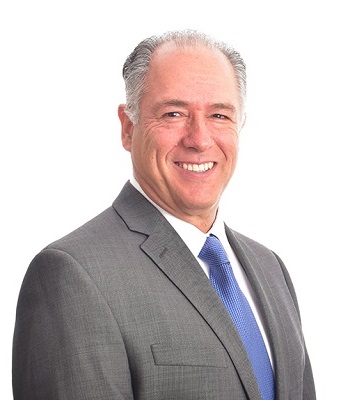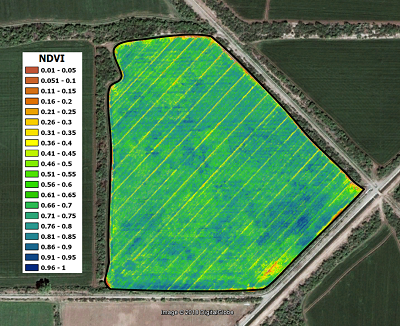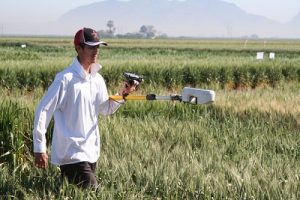Q+A with Iván Ortíz-Monasterio on nitrogen dosages and greenhouse gases
 Iván Ortíz-Monasterio, expert on sustainable intensification and wheat crop management at the International Maize and Wheat Improvement Center (CIMMYT), recently took part in a study detailing the detriments of excess fertilizer use and the benefits of more precise dosages.
Iván Ortíz-Monasterio, expert on sustainable intensification and wheat crop management at the International Maize and Wheat Improvement Center (CIMMYT), recently took part in a study detailing the detriments of excess fertilizer use and the benefits of more precise dosages.
In the following interview, he discusses the overuse of nitrogen fertilizer and related consequences, his experience with farmers, and his outlook for the future. According to Ortíz-Monasterio and study co-authors, research on wheat in the Yaqui Valley, state of Sonora, northwestern Mexico, and home to CIMMYT’s Norman E. Borlaug Experiment Station (CENEB), has direct implications for wheat crop management worldwide.
“The Yaqui Valley is agro-climatically representative of areas where 40 percent of the world’s wheat is grown, including places like the Indo-Gangetic Plains of India and Pakistan, the Nile Delta in Egypt, and the wheat lands of China,” said Ortíz-Monasterio.
- A key finding of the new publication was that, after a certain point, applying more nitrogen fertilizer does not increase yields, making excessive applications essentially a drain on farmers’ resources. Why then do farmers continue to apply more fertilizer than the crop needs?
Well there is a risk, if you under-apply N fertilizer, your yield goes down. Farmers are afraid that the yield will be lower and that their profit will be lower. The cost of under-applying for them is greater than the cost of over-applying, because they’re not paying all the costs of over applying. Those costs include the environmental impacts associated with greenhouse gas emissions, at a regional scale in the case of the Yaqui Valley because of nitrification of the Sea of Cortez, and at a local level due to contamination of the water table. All these costs are passed on to society. If we passed them on to farmers, then they would be more concerned about over-applying nitrogen fertilizers.
-Do you think farmers becoming more concerned is something that could happen?
Well there are starting to be more regulations in Europe. In the UK, farmers cannot apply any nitrogen before or at sowing; they can apply fertilizer only once the plant is about 15 centimeters tall. In other parts of Europe, like Germany, farmers cannot apply more than 150 kilograms of nitrogen on wheat, so it’s happening in other parts of the world. The government of Mexico and others are making commitments to reduce nitrous oxide emissions by 20 percent by 2030 and, in the case of agriculture, the main source of nitrous oxide is nitrogen fertilizer. To meet such commitments, governments will have to take policy action so, yes; I think there’s a good chance something will happen.
- There are technologies that can help farmers know precisely when to apply fertilizer and how much, for optimal crop yield and nitrogen use. Do many farmers use them? Why or why not?

NDVI (normalized difference vegetative index) map. Photo: CIMMYT.
Something interesting to me is what’s happening right now. For the last 10 years, we’ve been working with Yaqui Valley farmers to test and promote hand-held sensors and hiring farm advisors paid with government money who provide this service free to farmers, and adoption was high. Then the government removed the subsidy, expecting farmers to begin covering the cost, but
farmers didn’t want to pay for it.
Then a company that uses drones approached me and other researchers in the region and requested our help to convert wheat crop sensor data obtained using airborne drones to recommended fertilizer dosages. We agreed and, in their first year of operation, farmers growing wheat on 1,000 hectares paid for this service. I don’t know what it is—maybe seeing a colorful map is more sexy—but farmers seem to be willing to pay if you fly a drone to collect the data instead of having a farm advisor walk over the field. But it’s great! In the past we relied on the government to transfer the technology and now we have this great example of a private-public partnership, where a company is helping to transfer the technology and making a profit, so that will make it sustainable. I’m very excited about that!
-
Does CIMMYT have a plan to increase adoption of these technologies?

We’re not married to one technology, but need to work with all of them. You know we started with Greekseeker, which is a ground-based sensor, and now we’re also working with drones, with manned airplanes mounted with cameras, and even satellite images. So, there are four different ways to collect the data, and we’ve seen that the Greenseeker results correlate well with all of them, so the technology we developed originally for Greenseeker can be used with all the other platforms.
- Are you optimistic that farmers can shift their perceptions in this area and significantly reduce their nitrogen use?
I think we’re moving in that direction, but slowly. We need policy help from the government. Officials need to give some type of incentive to farmers to use the technology, because when farmers do something different they see it as a risk. To compensate for that risk, give them a carrot, rather than a stick, and I think that will help us move the technology faster.




